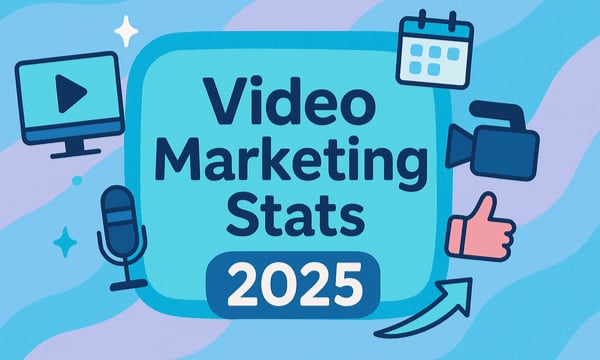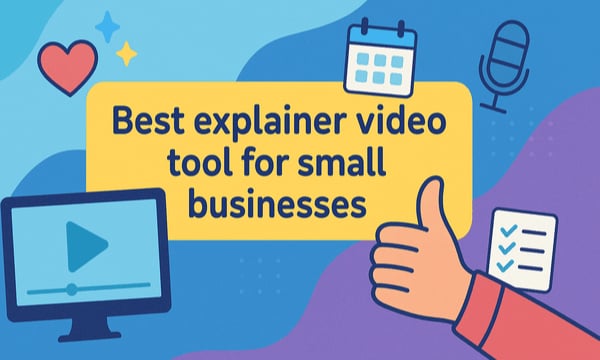One of the most important elements of marketing is reporting on and analyzing the success of your activities, and that's no different for video. How can you consistently improve your videos if you're not taking the time to reflect on what went well and what could be developed?
Plus, you've most likely invested time and money creating your marketing videos, so you need to ensure they're delivering the value you expect. But how should you approach measuring and reporting on your video marketing activities? We've created this guide to answer that very question, walking you through setting the right objectives to measuring the right metrics.
To make the process even easier and faster we've also created two FREE downloadable reporting templates. Firstly calculate your metrics quickly and easily with our video reporting calculator and then simply choose the metrics you want to report on, fill in the details and you've got a ready-made video marketing report that's perfect to share with your colleagues and management. Download it below 👇
Set SMART objectives
To be able to say whether your video has been a success or not, you have to define what success looks like to you? It could be that a certain number of people have bought your product after watching your video or it could be that a percentage of people have watched your video all the way through.
Whatever your objectives, make sure they link back to your overall marketing or business goals. There’s no point striving for social media engagement if your organization is focused on collecting email addresses to build out the contacts at the top of your marketing funnel.
They should also be SMART - that’s Specific, Measurable, Achievable, Realistic and Time-bound. No doubt you’ve heard this before but it’s a staple of objective setting for a reason - it works! Setting the right objectives can be deceptively tricky but working through this structure will ensure you have robust and productive goals in mind.
Determine the KPIs of your video marketing campaign
Once you know what you want to achieve, it’s time to choose some KPIs (Key Performance Indicators) to measure them. These measures should tie into your objectives and allow you to quantify how closely you’re tracking against your targets.
When it comes to choosing metrics to track, there’s plenty of options. The key here is not to get bogged down looking at every possible report that’s available for your videos because trust us there’s hundreds. Instead pick a handful that can definitively say whether you’re on target or not.
To give you some inspiration for your own - here are some common goal categories and their linked KPIs:
Goal 1: Increase traffic
Top metrics: Click-through rate and play rate.
The first goal of most video programs is to get eyes on the content you’re creating. You can measure that by your CTR, or how many people click to play.
Goal 2: Attract more new contacts
Top metrics: New social media subscribers and email conversion rate.
Need to build a list of contacts or generate more leads? Use lead forms that pop up when prospects are most engaged to collect their email or other contact information.
Goal 3: Qualify more prospects
Top metrics: view duration, engagement and audience insights.
If you're attracting viewers to your videos, it's time to start learning more about who they are and what they're interested in. Dig into the demographic analytics on YouTube and Facebook to better understand who is watching your videos and why. Or use pop-up forms on your website to ask more questions once watchers have got to a certain point in your video.
Goal 4: Generate leads or opportunities
Top metric: click-through rate, conversion rate and return on investment (ROI).
For a lot of us, the holy grail is generating leads and revenue from our video activities. To ensure you can accurately the return your videos are driving, make sure you take into account the costs of creating the video including software, time spent and salaries of those involved. This is the best way to determine whether your video had a net positive impact on your organization and marketing activities.
Let’s look at the other metrics you could choose from…
View count
Simply the number of people who have watched your video. However, this metric is tricky, as different video playing platforms measure the view count of videos differently.
On Facebook, it only takes 3 seconds of viewing to count as a complete 'view', while it’s an entire 30 seconds of playtime on YouTube. So determine which report you’ll be using and stick to that throughout for consistency.
Play rate
What percentage of people visit your website or social media pages and click to play your video. It's one thing to land on your website that has a video and another for them to actually click the magic play button. If your play rate is low consider changing your video thumbnail or editing the surrounding text to ensure it's as eye-catching as possible.
Average view duration
Did they get all the way to the end of your video or drop off half way through? This is a great metric that you can measure on YouTube. It shows you the point at which your viewers lose interest, giving you the opportunity to make edits and adjustments to improve audience retention.
If you're looking for extra tips on how to keep YouTube viewers engaged - we have a webinar packed full of advice. Check it out here.
Engagement with your video
By engagement, we mean likes, comments and shares on social media. This is an important measure because it can have multiple benefits:
- An indication of how well your video is being received.
- Often provides great qualitative feedback from comments which can help drive improvements to your products, services, or the video itself.
- Higher engagement boosts your organic social media reach
- You're building social proof for other prospective buyers and engaging your existing audience.
To see differences in response across each social network, we recommend breaking this down by channel.
Click-through rate
This measures how many people take your desired action of clicking to learn more, buying or sharing their contact details. If your click-through rate is low it could suggest that your call-to-action is in the wrong place or not compelling enough. Experiment with different placements and locations and learn from the results.
Conversion rate
The number of people who actually turned into a lead or a customer because of your video. This is one of the most powerful metrics and is usually a go-to for each video campaign.
Return on investment (ROI)
This is essentially saying how much money or value you made back versus the time and money invested in creating the video. You can calculate it with this formula: ROI = Net Profit / Total Investment * 100.
Negative feedback
While positive feedback is important, often you can learn even more from negative feedback. On Facebook you can see how many people unliked your page, hid your content or reported you as a result of your video. This is valuable insight as if this exceeds the number of people who engaged it could actually be damaging your brand. So don’t forget to look at it from both sides!
Top location and audience
As we mentioned earlier, it's one thing to see that people are watching your video but if you don't know anything about them, how can you ensure the next video you publish will interest them. That's why looking into the demographics of your audience is so powerful. This is very easy to understand across all social media platforms, just head into the 'Audience' section of your account.
Bounce rate
The number of people who land on your website and then leave. If you have a video front and centre, it’s going to greatly influence whether people leave or stay. The research suggests people stay longer on pages with video but if yours is doing the opposite it’s key to investigate.
Subscriber and fan growth
On YouTube it’s possible to see how many new subscribers you gained from each video. See if you can spot trends in those performing well - is it because you specifically asked them to subscribe or is the content just perfectly positioned to their needs? You can also get an insight into this on Facebook.
Learning from results and iterating
Now you know how your video performed, what do you do with that information? The unfortunate reality is that often we measure results and then that precious information sits untouched in a spreadsheet. To drive maximum value from your reporting, it’s key to highlight lessons learned at the end. By taking the time to think through exactly what this campaign taught you and how you could use that information to improve future campaigns you’re going to avoid making the same mistakes.
It might sound simple but having those points to return back to when you’re planning your next campaign will make all the difference and ensure you’re consistently moving forward.
To get started on your own video marketing report, download our FREE template today.




.png)



![How to create animation magic [3-part guide to video success]](https://blog.videoscribe.co/hubfs/How%20to%20create%20animation%20magic%20guide%20VideoScribe.png)


%20(1).png)


COMMENTS